Panasonic SAHT-15-EB, SAHT-15-EG, SAHT-15-EP Service manual

Specification
nAMPLIFIER SECTION
RMS output power of each channel driven
(at 240 V for areas other than continental Europe) 10 % total harmonic distortion
1 kHz front CH
60 W per channel (4 Ω)
1 kHz surround CH
60 W per channel (4 Ω)
1 kHz center CH
220 W per channel (4 Ω)
100 Hz subwoofer CH
240 W per channel (4 Ω)
700 W
35 W per channel (4 Ω)
1 kHz surround CH
35 W per channel (4 Ω)
1 kHz center CH
150 W per channel (4 Ω)
100 Hz subwoofer CH
160 W per channel (4 Ω)
Total DIN output power
450 W
DIN power output: Stereo Mode
(at 240 V for areas other than continental Europe) T.H.D. 1%
1 kHz front CH
ORDER NO. MD0503100C2
AV Control Receiver
SA-HT15EP
SA-HT15EG
SA-HT15EB
Color |
|
(S)....................... |
Silver Type |
|
35 W per channel (4 Ω) |
100 Hz subwoofer CH |
|
|
160 W per channel (4 Ω) |
Total DIN output power |
|
|
230 W |
Total harmonic distortion |
|
Half power at 1 kHz (Front CH) |
0.1% (4 Ω) |
Input sensitivity |
|
DVD, DVR/VCR, TV, GAME/AUX |
400 mV, IHF’66 |
S/N at rated power (4 Ω) |
|
DVD, DVR/VCR, TV, GAME/AUX |
75 dB (85 dB, IHF’66) |
Input impedance |
|
DVD, DVR/VCR, TV, GAME/AUX |
47 kΩ |
Tone controls |
|
BASS |
50 Hz, +10 to -10 dB |
TREBLE |
20 kHz, +10 to -10 dB |
Digital input |
|
OPTICAL |
2 |
COAXIAL |
1 |
nFM TUNER SECTION |
|
Frequency range |
87.50-108.00 MHz |
Sensitivity |
|
S/N 30 dB |
1.5 µV/ 75 Ω |
S/N 26 dB |
1.3 µV/ 75 Ω |
S/N 20 dB |
1.2 µV/ 75 Ω |
IHF usable sensitivity |
(IHF’58) 1.5 µV/ 75 Ω |
IHF 46 dB stereo quieting sensitivity |
22 µV/ 75 Ω |
Total harmonic distortion |
|
MONO |
0.2% |
STEREO |
0.3% |
© 2005 Matsushita Electric Industrial Co. Ltd.. All rights reserved. Unauthorized copying and distribution is a violation of law.

SA-HT15EP / SA-HT15EG / SA-HT15EB
S/N
MONO
STEREO
Frequency response
Image rejection at 98 MHz IF rejection at 98 MHz Stereo separation
1 kHz Antenna terminal
nAM TUNER SECTION Frequency range
Sensitivity
Selectivity (at 999 kHz) nGENERAL
Power supply (For United Kingdom) Power supply (For Continental Europe) Power consumption
(Main unit) (Subwoofer)
Dimensions (W × H × D) (Main unit) Mass (Main unit)
Power consumption in standby mode: nSYSTEM
System: SC-HT15 (EP)
Main unit: SA-HT15 (EP) Satellite Speaker: SB-HT15 (P) Active Subwoofer: SB-WA15 (E)
System: SC-HT15 (EG)
Main unit: SA-HT15 (EG) Satellite Speaker: SB-HT15 (P) Active Subwoofer: SB-WA15 (E)
System: SC-HT15 (EB)
Main unit: SA-HT15 (EB) Satellite Speaker: SB-HT15 (P)
Active Subwoofer: SB-WA15 (EB)
Speaker: SB-HT15 (P)
Front speakers: SB-FS15 (P-S) x 2 Surround speakers: SB-FS880 (EG-S1) x 2 Center speaker: SB-PC15 (P-S) x 1
Notes:
1.Specifications are subject to change without notice. Mass and dimensions are approximate.
2.Total harmonic distortion is measured by the digital spectrum analyzer.
For main unit
Marking sign is located on bottom of the unit.
* Manufactured under license from Dolby Laboratories.
“Dolby”, “Pro Logic” and the double-D symbol are trademarks of Dolby Laboratories.
** Manufactured under license from Digital Theater System.
“DTS” and “DTS Digital Surround” are trademarks of Digital Theater System.
CONTENTS
|
|
Page |
Page |
|
1 |
Caution for AC Mains Lead |
4 |
10.3. Disassembly of Top Cabinet |
13 |
2 |
Use of Active Subwoofer |
5 |
10.4. Disassembly of Rear Panel |
13 |
|
2.1. Checking Player when Active Subwoofer is Used |
5 |
10.5. Disassembly of Front Panel |
13 |
|
2.2. Checking Main Unit Using Power Jig |
5 |
10.6. Disassembly of Panel P.C.B. |
14 |
3 |
Before Repair and Adjustment (Using Active Subwoofer Unit) |
10.7. Disassembly of Function P.C.B. & Volume P.C.B. |
14 |
|
|
|
6 |
10.8. Disassembly of DSP P.C.B. |
15 |
4 |
Safety Precautions |
6 |
10.9. Disassembly of Main P.C.B. |
15 |
|
4.1. GENERAL GUIDELINES |
6 |
11 Service Position |
16 |
5 |
Handling the Lead Solder |
7 |
11.1. Checking the DSP P.C.B. (Side A) |
16 |
|
5.1. About lead free solder (PbF) |
7 |
11.2. Checking the Main P.C.B., Panel P.C.B., Function P.C.B., |
|
6 |
About the Protection Circuitry |
7 |
Volume P.C.B. & DSP P.C.B. (Side B) |
16 |
7 |
Accessories |
8 |
12 Self Diagnosis Display Function |
17 |
8 |
Operation Procedures |
9 |
12.1. Automatically Displayed Error Codes |
17 |
9 |
Remote Control |
10 |
12.2. Error Code Display Details |
17 |
10 |
Assembling and Disassembling |
11 |
12.3. Activating Self Diagnosis Function (Doctor Mode) |
17 |
|
10.1. Disassembly flow chart |
11 |
12.4. Activating Self Diagnosis Function (Service Mode) |
18 |
|
10.2. P.C.B. Positions |
12 |
12.5. The Shutdown And Short Circuit Protection Detection |
19 |
2
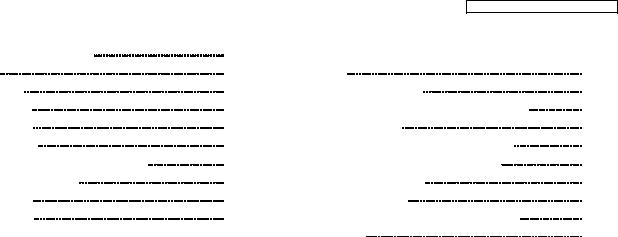
SA-HT15EP / SA-HT15EG / SA-HT15EB
|
12.6. Returning to Normal Display |
20 |
|
15.3. (C) Panel P.C.B., (D) Volume P.C.B. & (E) Function |
|
13 |
Block Diagram |
21 |
|
P.C.B. |
43 |
14 |
Schematic Diagram |
26 |
16 |
Wiring Connection Diagram |
45 |
|
14.1. (A) DSP Circuit |
27 |
17 |
Type Illustration of IC s, Transistors and Diodes |
46 |
|
14.2. (B) Main Circuit |
30 |
18 |
Terminal Function of IC |
47 |
|
14.3. (C) Panel Circuit |
37 |
|
18.1. IC900 (C2CBHG000166): Microprocessor |
47 |
|
14.4. (D) Volume Circuit & (E) Funtion Circuit |
38 |
19 |
Parts Location and Replacement Parts List |
48 |
15 |
Printed Circuit Board Diagram |
39 |
|
19.1. Cabinet Parts Location |
49 |
|
15.1. (A) DSP P.C.B. |
39 |
|
19.2. Electrical Parts List |
51 |
|
15.2. (B) Main P.C.B. |
41 |
|
19.3. Packing Materials & Accessories Parts List |
57 |
|
|
|
|
19.4. Packaging |
58 |
3

SA-HT15EP / SA-HT15EG / SA-HT15EB
1 Caution for AC Mains Lead
4

http://getMANUAL.com
SA-HT15EP / SA-HT15EG / SA-HT15EB
2 Use of Active Subwoofer
2.1.Checking Player when Active Subwoofer is Used
1.This unit uses the active subwoofer to supply the power of the component, and the active subwoofer should be connected to the component to check operational conditions of the component.
2.2.Checking Main Unit Using Power Jig
If the active subwoofer is not available during time of repair to the unit, the following equipment could be used.
Jig product number
RFKZ0182 (110V , 127V, 220V, 230V - 240V for with voltage selector overseas domestic use).
5

SA-HT15EP / SA-HT15EG / SA-HT15EB
3 Before Repair and Adjustment (Using Active Subwoofer
Unit)
Disconnect AC power, discharge Power Supply Capacitors C546, C547, C548 & C549 through a 10 Ω, 1W resistor to ground. DO NOT SHORT-CIRCUIT DIRECTLY (with a screwdriver blade, for instance), as this may destroy solid state devices.
After repairs are completed, restore power gradually using a variac, to avoid overcurrent. Current consumption at AC 120V, 60Hz in NO SIGNAL mode should be ~700 mA .
4 Safety Precautions
4.1.GENERAL GUIDELINES
1.When servicing, observe the original lead dress. If a short circuit is found, replace all parts which have been overheated or damaged by the short circuit.
2.After servicing, see to it that all the protective devices such as insulation barriers, insulation papers shields are properly installed.
3.After servicing, make the following leakage current checks to prevent the customer from being exposed to shock hazards.
4.1.1.LEAKAGE CURRENT COLD CHECK
1.Unplug the AC cord and connect a jumper between the two prongs on the plug.
2.Measure the resistance value, with an ohmmeter, between the jumpered AC plug and each exposed metallic cabinet part on the equipment such as screwheads, connectors, control shafts, etc. When the exposed metallic part has a return path to the chassis, the reading should be between 1MΩ and 5.2Ω.
When the exposed metal does not have a return path to the chassis, the reading must be  .
.
Fig. 1
4.1.2.LEAKAGE CURRENT HOT CHECK (See Figure 1.)
1.Plug the AC cord directly into the AC outlet. Do not use an isolation transformer for this check.
2.Connect a 1.5kΩ, 10 watts resistor, in parallel with a 0.15µF capacitors, between each exposed metallic part on the set and a good earth ground such as a water pipe, as shown in Figure 1.
3.Use an AC voltmeter, with 1000 ohms/volt or more sensitivity, to measure the potential across the resistor.
4.Check each exposed metallic part, and measure the voltage at each point.
5.Reverse the AC plug in the AC outlet and repeat each of the above measurements.
6.The potential at any point should not exceed 0.75 volts RMS. A leakage current tester (Simpson Model 229 or equivalent) may be used to make the hot checks, leakage current must not exceed 1/2 milliamp. In case a measurement is outside of the limits specified, there is a possibility of a shock hazard, and the equipment should be repaired and rechecked before it is returned to the customer.
6

SA-HT15EP / SA-HT15EG / SA-HT15EB
5 Handling the Lead Solder
5.1.About lead free solder (PbF)
Distinction of PbF P.C.B. :
P.C.B.s (manufactured) using lead free solder will have a PbF stamp on the P.C.B.
Caution:
·Pb free solder has a higher melting point that standard solder; Typically the melting point is 50 - 70°F (30 - 40°C) higher. Please use a high temperature soldering iron. In case of the soldering iron with temperature control, please set it to 700 ± 20°F (370 ± 10°C).
·Pb free solder will tend to splash when heated too high (about 1100°F/600°C).
·When soldering or unsoldering, please completely remove all of the solder on the pins or solder area, and be sure to heat the soldering points with the Pb free solder until it melts enough.
6 About the Protection Circuitry
The protection circuitry may have operated if either of the following conditions is noticed: *No sound is heard when the power is supplied.
*Sound stops during a performance.
The functions of this circuitry is to prevent circuitry damage, for example, the positive and negative speaker connection wires are “shorted”, or if speaker systems with an impedance less than the indicated rated impedance of this unit are used.
If this occurs, follow the procedure outlined below:
1.Press the STANDBY  /ON button, switch to STANDBY mode.
/ON button, switch to STANDBY mode.
2.Determine the cause of the problem and correct it.
3.Press the STANDBY  /ON button once again, supply the power.
/ON button once again, supply the power.
Note:
When the protection circuitry functions, the unit will not operate unless the STANDBY  /ON button is first switched STANDBY and then ON again.
/ON button is first switched STANDBY and then ON again.
7
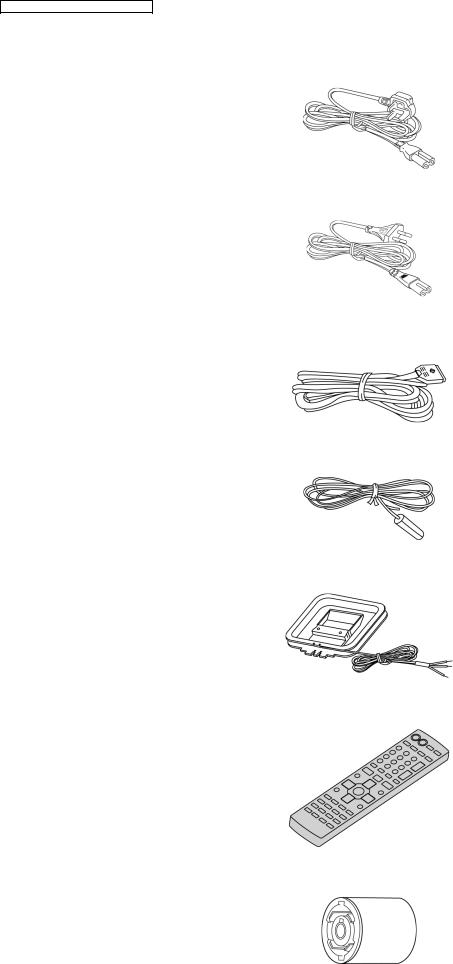
SA-HT15EP / SA-HT15EG / SA-HT15EB
7 Accessories
AC cord (For EB only)
AC cord (For EG & EP only)
System cable
FM indoor antenna
AM loop antenna
Remote control
Antenna plug adapter (For EB only)
8
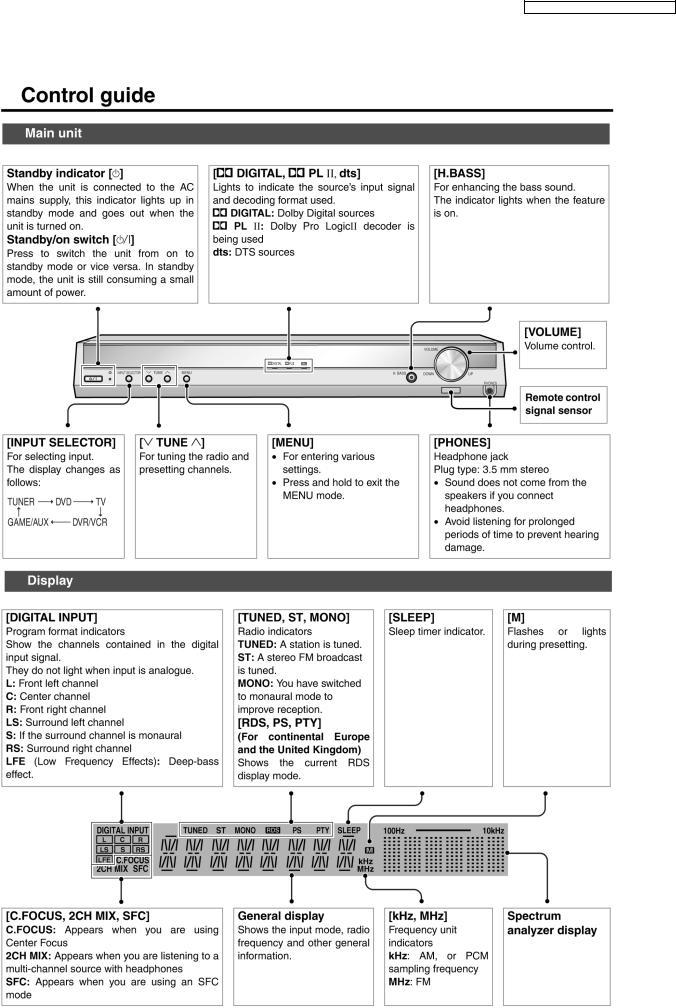
SA-HT15EP / SA-HT15EG / SA-HT15EB
8 Operation Procedures
9
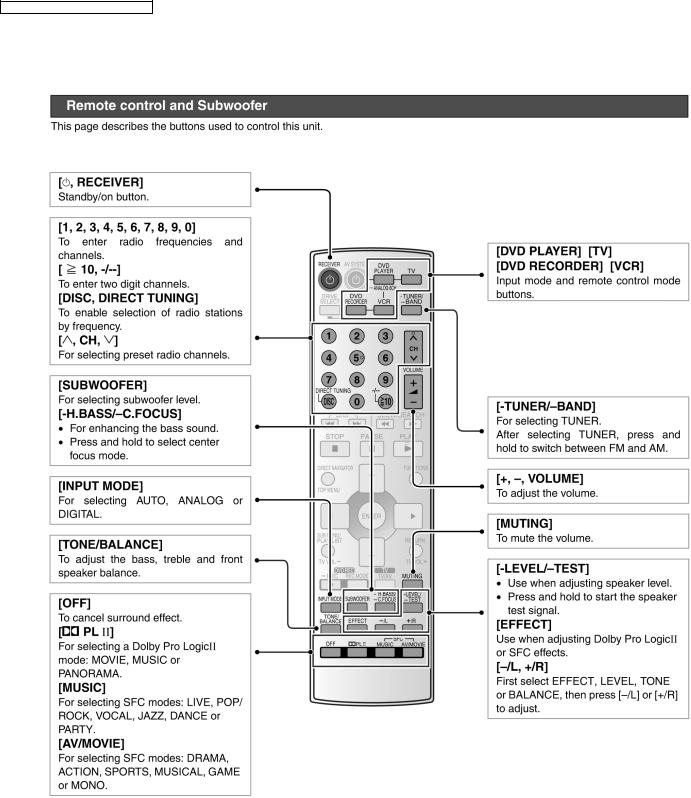
SA-HT15EP / SA-HT15EG / SA-HT15EB
9 Remote Control
10

SA-HT15EP / SA-HT15EG / SA-HT15EB
10 Assembling and Disassembling
“ATTENTION SERVICER”
Some chassis components may have sharp edges. Be careful when disassembling and servicing.
1.This section describes procedures for checking the operation of the major printed circuit boards and replacing the main components.
2.For reassembly after operation checks or replacement, reverse the respective procedures. Special reassembly procedures are described only when required.
3.Select items from the following index when checks or replacement are required.
Warning:
This product uses a laser diode. Refer to caution statement Precaution of Laser Diode.
ACHTUNG:
Die Lasereinheit nicht zerlegen.
Die Lasereinheit darf nur gegen eine vom Hertsteller spezifizierte Einheit ausgetauscht werden.
10.1. Disassembly flow chart
The following chart is the procedure for disassembling the casing and inside parts for internal inspection when carrying out the servicing.
To assemble the unit, reverse the steps shown in the chart as below.
11
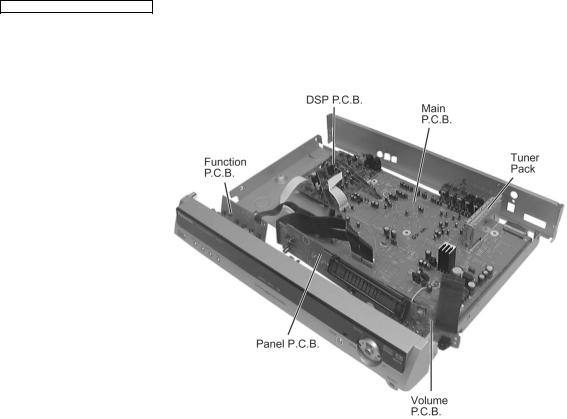
SA-HT15EP / SA-HT15EG / SA-HT15EB
10.2. P.C.B. Positions
12
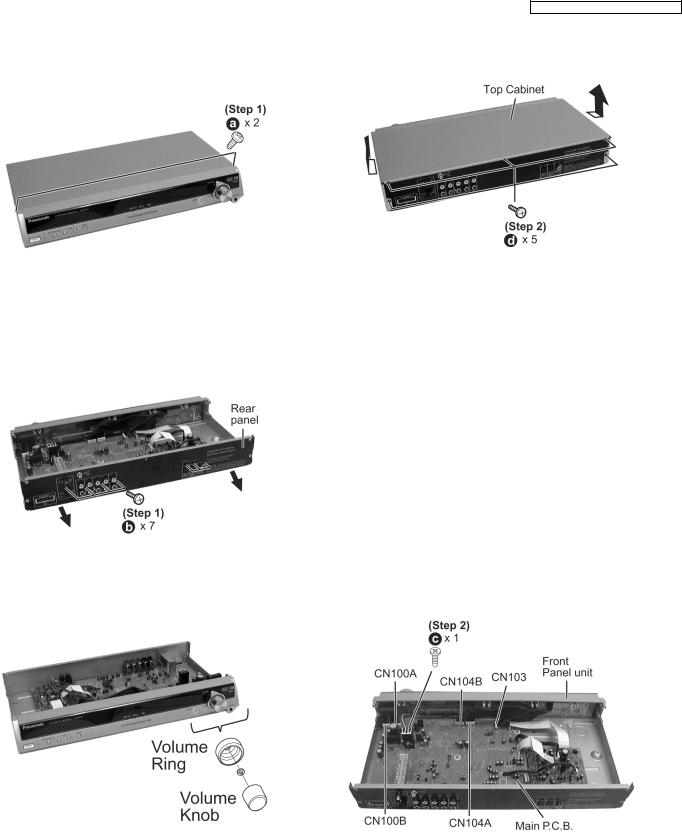
10.3. Disassembly of Top Cabinet
Step 1: Remove 2 screws.
Step 2 : Remove 5 screws at rear panel.
SA-HT15EP / SA-HT15EG / SA-HT15EB
Step 3 : Open and lift up the top cabinet in the direction of arrow shown.
10.4. Disassembly of Rear Panel
· Follow the (Step 1) - (Step 3) of item 10.3 - Disassembly of Top Cabinet Step 1 : Remove 7 screws, pull rear panel forward
in the arrow shown.
10.5. Disassembly of Front Panel
· Follow the (Step 1) - (Step 3) of item 10.3 - Disassembly of Top Cabinet Step 1 : Remove the volume knob.
Step 2 : Remove 1 screw securing the grounding at Main P.C.B..
Step 3 : Detach wire connectors (CN103, CN104A, CN104B, CN100A & CN100B).
Step 4 : Release claws & catches and push the front panel forward as arrow shown.
13

SA-HT15EP / SA-HT15EG / SA-HT15EB
NOTE: When assembling the front panel unit, alight the 2 catches properly.
10.6. Disassembly of Panel P.C.B.
·Follow the (Step 1) - (Step 3) of item 10.3 - Disassembly of Top Cabinet
·Follow the (Step 1) - (Step 4) of item 10.5 - Disassembly of Front Panel Step 1 : Remove 5 screws at Panel P.C.B..
10.7. Disassembly of Function P.C.B. & Volume P.C.B.
·Follow the (Step 1) - (Step 3) of item 10.3 - Disassembly of Top Cabinet
·Follow the (Step 1) - (Step 4) of item 10.5 - Disassembly of Front Panel
·Follow the (Step 1) of item 10.6 - Disassembly of Panel P.C.B.
Step 1 : Remove 5 screws at Function P.C.B. and 4 screws at
Volume P.C.B..
14
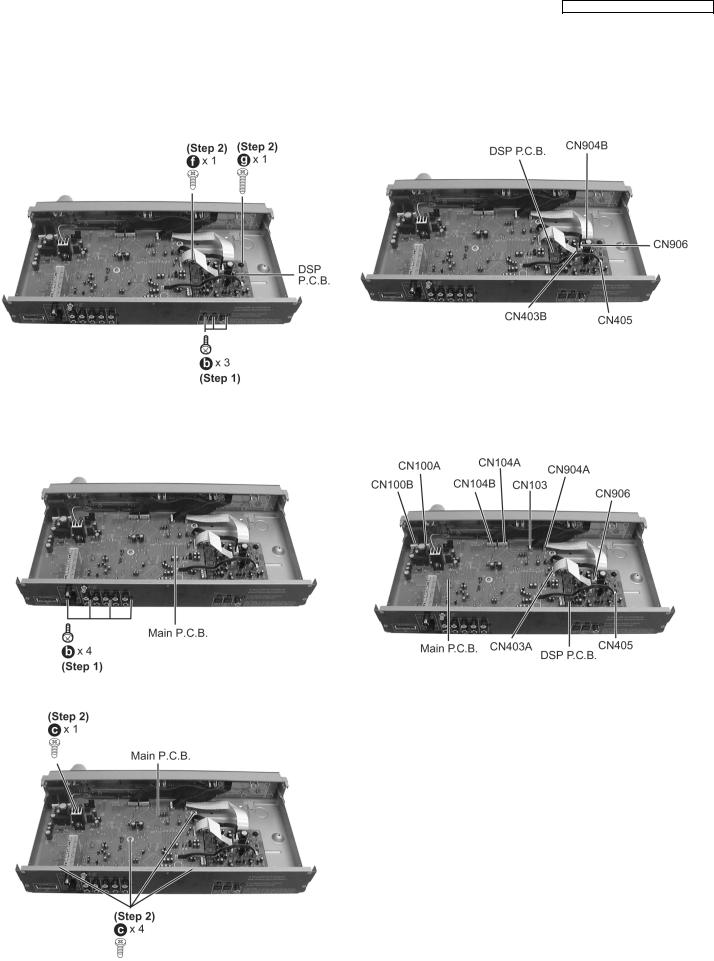
http://getMANUAL.com
SA-HT15EP / SA-HT15EG / SA-HT15EB
10.8. Disassembly of DSP P.C.B.
· Follow the (Step 1) - (Step 3) of item 10.3 - Disassembly of Top Cabinet
Step 1 : Remove 3 screws at rear panel. Step 2 : Remove 2 screws at DSP P.C.B..
Step 3 : Disconnect 4 connectors (CN904B, CN906, CN405 & CN403B) at DSP P.C.B..
10.9. Disassembly of Main P.C.B.
· Follow the (Step 1) - (Step 3) of item 10.3 - Disassembly of Top Cabinet Step 1 : Remove 4 screws at rear panel.
Step 2 : Remove 5 screws at Main P.C.B..
Step 3 : Disconnect connectors (CN100B, CN100A, CN104B, CN104A, CN103, CN904A & CN403A) at Main P.C.B. & 2 connectors (CN906 & CN405) at DSP P.C.B..
15

SA-HT15EP / SA-HT15EG / SA-HT15EB
11 Service Position
Note:
Checking of all Major P.C.B. (Main P.C.B., DSP P.C.B., Volume P.C.B., Panel P.C.B. & Function P.C.B.) can be carried out using below procedures.
For the disassembling procedure, see Section 10.
11.1. Checking the DSP P.C.B. (Side A)
1.Remove Top Cabinet.
2.Remove Rear Panel.
11.2.Checking the Main P.C.B., Panel P.C.B., Function P.C.B., Volume P.C.B. & DSP P.C.B. (Side B)
1.Remove Top Cabinet.
2.Remove Rear Panel.
3.Disassembly of Front Panel.
4.Disassembly of Panel P.C.B., Function P.C.B., Volume P.C.B., Main P.C.B. & DSP P.C.B..
5.Flip the PCBs over (see as shown in picture below).
16

SA-HT15EP / SA-HT15EG / SA-HT15EB
12 Self Diagnosis Display Function
This unit is equipped with the self diagnosis display function, which alarms faulty operation with error code. Use this function during servicing.
12.1. Automatically Displayed Error Codes
An error code automatically appears on the display (FXX) when faulty operation is detected. Refer to Fig. 12.1. For error codes, refer to Section 12.2.
<Fig.12.1>
12.2. Error Code Display Details
Refer to the following table for error codes.
FL Display |
Symptom |
Cause and Remedy |
OVERLOAD |
Speaker short, amplifier failure. |
Speaker short and failure in power |
|
Humidity protection activated. |
amplifier, pre-amplifier circuits. Check for |
|
|
faulty parts and replace with new parts if |
|
|
necessary. |
FAN LOCK |
The fan stops suddenly. |
Failure in fan or fan control circuits. Check |
|
|
for faulty parts and replace with new parts |
|
|
if necessary. |
F70 |
Communication error between sub micro |
Failure sub-micro processor and its |
|
processor and its peripheral LSI |
peripherals LSI. Check for faulty aprts and |
|
|
replace with new parts if necessary. |
F76 |
When the power is turned on, the unit |
Failure in the power circuit system of the |
|
power autimatically turns off, the power |
unit. This may happen when the direct |
|
cannot be turned on. |
current electricity is supplied to speaker |
|
|
terminals. Check for the above and replace |
|
|
with new parts if necessary. |
12.3. Activating Self Diagnosis Function (Doctor Mode)
This mode can be used during servicing.
1.With the following operation, the processing of this mode begins.
·Press and hold down the “INPUT SELECTOR” button and the “HARMONIC BASS” button, and then press the “POWER” button at the same time.
*At this time, initialize all setting and set the following frequency to tuner. FL display will display “_DOCTOR_” for 3 seconds. E1: 99.7 MHz, E2/3: 93.40 MHz, JAPAN: 87.8 MHz
*The display is always blinked with 1Hz cycle to indicate that DOCTOR MODE is activated.
2. Normal function for all buttons on the unit.
17
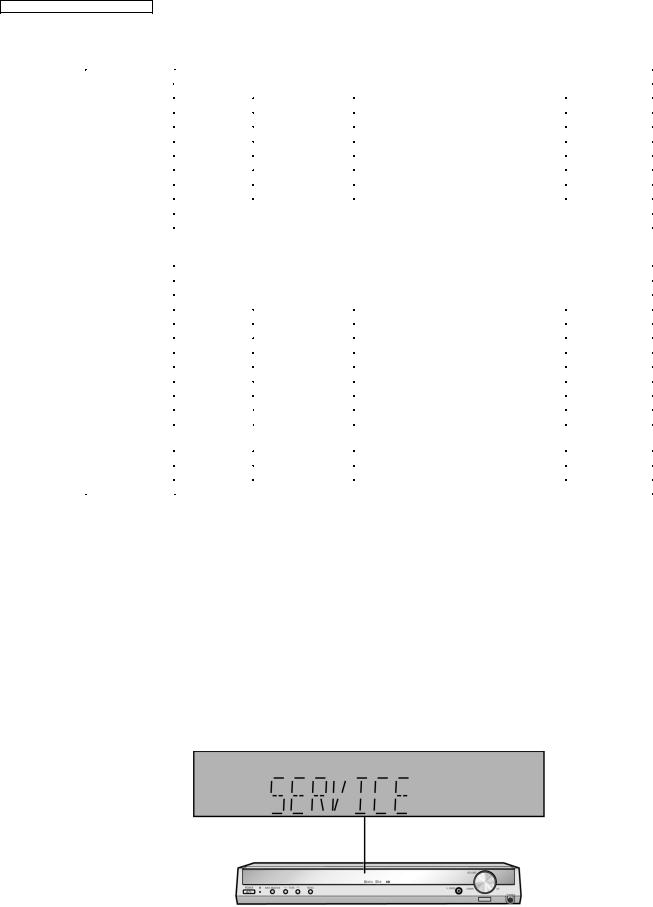
SA-HT15EP / SA-HT15EG / SA-HT15EB
3. Doctor mode function at some remote control codes as table below.
Remote Control |
|
Test Mode Function and settings |
|
|
|
Selector |
Sound Mode |
Other setting |
Vol/Tone |
CH 1 |
TUNER |
STEREO |
Frequency : FM min. *1) |
-48dB/0dB |
CH 2 |
TUNER |
STEREO |
Frequency : FM max. |
-48dB/0dB |
CH 3 |
TUNER |
STEREO |
FM 98.3 MHz. |
-18dB/0dB |
CH 4 |
TUNER |
STEREO |
Frequency : AM min. |
-48dB/0dB |
CH 5 |
TUNER |
STEREO |
Frequency : AM max. |
-48dB/0dB |
CH 6 |
TUNER |
STEREO |
AM 765 kHz (9kHz/step) |
-18dB/0dB |
CH 7 |
TUNER |
STEREO |
AM 770 kHz (10kHz/step) |
-18dB/0dB |
CH 8 |
If the input selector is TUNER, auto |
tuning function is started to upward on current |
frequency. |
|
CH 9 |
If the input selector is TUNER, auto tuning function is started to downward on current frequency. |
|||
CH 0 |
All indicators of FL are displayed. All LED are off. |
|
||
|
Note: After this setting, only “POWER” button or “CHECKER COMMAND” code by the remote control |
|||
|
can be entered. |
|
|
|
CH UP |
Check Main uP software Version. |
|
|
|
CH DOWN |
Display [SUM_****]; **** is checksum. If no ROM correction, display [NO_EPROM]. |
|||
SUBWOOFER |
VCR (Analog) |
---- |
- |
-18dB/0dB |
MUTING |
DVD 6 CH |
---- |
- |
-18dB/0dB |
INPUT MODE |
GAME/ AUX |
STEREO |
Analog |
-18dB/0dB |
SLEEP |
TV |
STEREO |
Analog |
-18dB/0dB |
TONE/BAL |
DVD |
STEREO |
Analog |
-18dB/0dB |
LEVEL |
DVR/VCR |
STEREO |
Analog |
-18dB/0dB |
EFFECT |
DVD |
STEREO |
Digital (COAX) |
-48dB/0dB |
STEREO |
TV |
STEREO |
Digital (OPT 1) |
-48dB/0dB |
PL2 |
DVR/VCR |
STEREO |
Digital (OPT 2) |
-48dB/0dB |
TEST |
No change |
SURROUND |
Scan the test noise output channel with |
-18dB/0dB |
|
|
|
500ms intervals. |
|
-/L |
GAME/ AUX |
STEREO |
Balance is set to leftmost. |
-18dB/0dB |
+/R |
GAME/ AUX |
STEREO |
Balance is set to rightmost. |
-18dB/0dB |
DIMMER |
If the input selector is TUNER in E2 |
mode, Display mode (PS/PTY) is changed. |
|
|
*By the model setting, when there is not a function, ignore it. (ex. INPUT MODE in HT15 mode)
*Auto decode mode cannot activate in Doctor Mode.
*1) Memorize this frequency once in CH1 to 7 and recall it.
4.After enter the remote control code “DIRECT (TUNING)”, the message “OK” will appear for 0.2s second when each button is press one by one.
5.Press “POWER” button on main unit or remote control to exit this mode.
12.4. Activating Self Diagnosis Function (Service Mode)
This mode is used for purpose of servicing.
1.With the following operation, the processing of this mode begins.
·Press and hold down the “HARMONIC BASS” button and the “TUNING DOWN” button, and then press the “POWER” button at the same time.
*At this time, initialize all setting and set the following frequency to Tuner. FL display will display “SERVICE” for 3 seconds.
2. To confirm the uP software Version: Press “TUNING DOWN” button on main unit, “MS085 **” is displayed.
18
